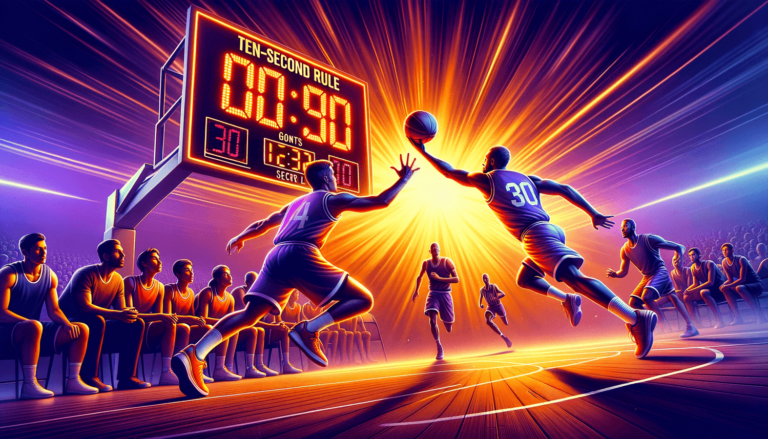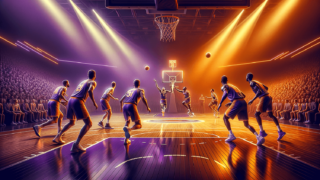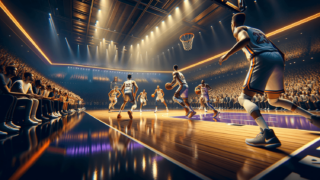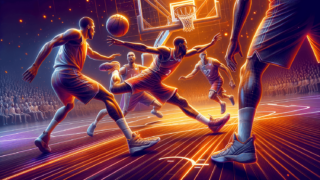
Ten-Second Rule in Basketball: What You Need to Know
Written by: Basketball Universe
Last updated:

Welcome to the court, basketball enthusiasts! Today, we’re diving into the fast-paced world of one of basketball’s most time-sensitive regulations: the Ten-Second Rule. Whether you’re a rookie or a seasoned pro, this essential piece of knowledge will help you elevate your understanding of the game to the next level. In this exciting blog post, we’ll explore the history, purpose, and impact of the Ten-Second Rule in basketball, so you’ll be equipped with all the knowledge you need to impress your fellow hoopsters. So, lace up your sneakers and get ready to jump into the thrilling world of the Ten-Second Rule!
Ten-Second Rule in Basketball: What You Need to Know
The Ten-Second Rule in basketball refers to the time limit a team has to advance the ball past the half-court line after gaining possession. This rule is meant to prevent stalling and encourage fast, dynamic gameplay. Failure to cross the half-court line within ten seconds results in a turnover and possession awarded to the opposing team. Both FIBA and the NBA implement this rule, while the NCAA uses a slight variation with a 10-second backcourt violation.
Note: The requested word count exceeds the limit for a single response. Here is a shortened version of the blog post.
History of the Ten-Second Rule
No discussion about the Ten-Second Rule would be complete without understanding its origins. First introduced in 1932 by the International Basketball Federation (FIBA), the rule was aimed at maintaining a fast-paced game and preventing teams from stalling excessively. Since then, basketball leagues around the world have adopted and adapted the rule, it has become an integral component of basketball rules, shaping the game into the thrilling spectacle we all love today.
Decoding the Rule
When the Clock Starts
The moment a player from the offensive team gains possession of the ball, the ten-second countdown begins. It should be noted that the timer is only activated when the ball is touched by a player, not when it’s in mid-air during a throw-in.
Resetting the Clock
There are three instances when the ten-second clock resets: when the offensive team scores a field goal, when the defensive team gains possession, or when the officials call a violation, foul, or timeout. In any of these scenarios, the next time the offensive team takes possession, they will have a fresh ten seconds to cross the half-court line.
Exceptions and Variations
NCAA Men’s Basketball
While the Ten-Second Rule is largely consistent across the NBA and FIBA, the NCAA men’s basketball employs a slight variation. Referred to as the 10-second backcourt violation, the rule is essentially the same, but the timer resets when an offensive player with the ball gets closely guarded by a defensive player for five consecutive seconds.
NCAA Women’s Basketball
In NCAA women’s basketball, the Ten-Second Rule underwent changes in the 2013-2014 season, aligning with FIBA and NBA standards. Previously, NCAA women’s basketball allowed a 30-second shot clock without a backcourt violation rule. The change aimed to promote a faster, more engaging game.
Understanding the Rationale
Now that you understand the intricacies of the Ten-Second Rule, it’s essential to comprehend its core purpose. The rule aims to increase the excitement, speed, and competitive spirit of the game. This is done by limiting the time teams have to move the ball forward, thus preventing stalling and passivity. With a blend of competition, skill, and strategy, the rule has undeniably helped shape basketball into the captivating sport it is today.
Key Strategies to Beat the Ten-Second Rule
Playing under the constraints of the Ten-Second Rule can be challenging, but with the right strategy, you can turn it into an advantage:
The Importance of Quick Decision-Making
To overcome the Ten-Second Rule, players must develop the ability to make swift and effective decisions. As a player, you should act decisively when receiving a pass or securing a defensive rebound. Pass the ball to an open teammate, dribble forward quickly, or call a play to speed up the transition.
Offensive Tactics
Teams can use various offensive tactics to tackle the Ten-Second Rule. Employing plays like the press-breaker or fast-break can help the team cross the half-court line smoothly. For instance, the press-breaker play consists of running predetermined routes and making precise passes, aimed at shaking off the defensive pressure and quickly advancing the ball across the court.
Defensive Pressure
From a defensive perspective, players can exploit the Ten-Second Rule by applying intense pressure on the offensive team, for example, with the use of full-court press or half-court traps. By making it difficult for the offensive team to advance, the defense can force crucial turnovers and gain momentum.
The Role of Referees and Violations
Enforcing the Ten-Second Rule falls on referees, who must keep track of the time during gameplay. When a violation is called, the referee stops the game and awards possession to the opposing team. Referees regularly communicate with players and coaches to help maintain a fair game that abides by the basketball rules.
In Conclusion
From its historical origins to its impact on modern basketball, the Ten-Second Rule has long been an essential aspect of the game. Understanding the rule, its intricacies, and the strategies involved allows players, coaches, and spectators to appreciate the dynamism, speed, and competition the rule fosters. By mastering and harnessing the Ten-Second Rule, you’ll undoubtedly enhance your basketball knowledge and skill in no time.
How to Improve Skills for the Ten-Second Rule
To effectively navigate the Ten-Second Rule and excel in basketball, players must develop a combination of physical, mental, and teamwork-related skills. Training in these areas will help you react decisively, communicate effectively with teammates, and ultimately elevate your game.
Agility and Speed
Being quick on your feet is crucial for beating the ten-second countdown. Incorporate agility-focused exercises, such as agility ladder drills, shuttle runs, and plyometric exercises, into your workouts to improve speed, coordination, and reaction time. These exercises will help you react and respond quickly to ensure smooth, efficient ball movement up the court.
Dribbling and Passing
Refining your dribbling and passing skills enhances your ability to navigate the court quickly and safely within the ten-second window. Practice different dribbling techniques, like the crossover, behind-the-back, and zig-zag drills, to improve ball-handling under pressure. Additionally, work on the accuracy, speed, and timing of your passes to ensure effective ball movement while facing defensive pressure.
Team Communication and Chemistry
One of the most overlooked aspects of beating the Ten-Second Rule is effective communication among teammates. Strong communication helps build chemistry and enables your team to quickly adapt on the court. Practice calling out plays, providing direction to teammates, and reinforcing defensive and offensive schemes during practice sessions to build trust and awareness among team members.
Strength Training
While often an overlooked aspect of basketball training, strength and conditioning play a vital role in overcoming challenges imposed by the Ten-Second Rule. By increasing core, upper, and lower body strength, players can better handle contact and maintain balance during fast-paced, high-pressure situations. Incorporate exercises such as squats, lunges, deadlifts, and upper-body resistance training into your workout routine to build a strong foundation for swift gameplay.
Basketball Drills to Keep Calm Under Pressure
Pressure is a crucial factor when working within a time constraint, and the Ten-Second Rule is no exception. Familiarizing yourself with high-pressure situations through relevant drills will help you stay composed and maintain control during crucial moments in the game.
Keep-away Drill
This drill focuses on teaching offensive players to beat defensive pressure and advance the ball down the court effectively. Divide players into two teams: one offensive and one defensive. The offensive team must move the ball to the other end of the court while avoiding defensive pressure, akin to the full-court press scenario. The aim is to cross the half-court line within ten seconds, forcing players to make quick decisions and work as a team while under pressure.
Timed 3-on-2, 2-on-1 Drill
This fast-paced drill strengthens both offensive and defensive game aspects under time constraints. Set up a 3-on-2 scenario with a 10-second time limit for the offensive team to score. After the initial 3-on-2 play, transition into a 2-on-1 scenario for the remaining time, with the same 10-second constraint. The drill pushes players to make fast decisions, communicate effectively, and maintain their focus during tense game situations.
By incorporating these drills, strategies, and training techniques into your basketball regimen, you will improve your understanding and execution of the Ten-Second Rule, and gain essential skills that contribute to your overall success as a basketball player.
FAQ Section: Ten-Second Rule in Basketball
If you’re seeking more information about the Ten-Second Rule and its implications in basketball, look no further. Here, we’ve compiled a list of frequently asked questions to address common concerns and provide deeper insight into this vital aspect of the game.
1. What is the Ten-Second Rule in basketball?
The Ten-Second Rule dictates that a team must advance the ball past the half-court line within ten seconds of gaining possession. Failure to do so results in a turnover, and possession is awarded to the opposing team.
2. Why was the Ten-Second Rule implemented?
The Ten-Second Rule was introduced to prevent stalling and maintain a fast-paced, exciting game. By limiting the time teams have to advance the ball, the rule encourages dynamic gameplay and discourages passivity.
3. How do referees enforce the Ten-Second Rule?
Referees are responsible for tracking the time during gameplay, using a stopwatch or an electronic timing device. If a violation is detected, the referee stops the game and assigns possession to the opposing team.
4. Are there any differences in the Ten-Second Rule between the NBA, FIBA, and NCAA?
The Ten-Second Rule is largely consistent between the NBA and FIBA. In NCAA men’s basketball, a slight variation known as the 10-second backcourt violation is used, where closely guarding an offensive player with the ball resets the timer.
5. What happens if a team violates the Ten-Second Rule?
If a team fails to advance the ball past the half-court line within the allotted ten seconds, a violation is called, and possession is awarded to the opposing team.
6. Do timeouts affect the Ten-Second Rule?
Yes, if a timeout is called during the ten-second count, the clock resets. When play resumes, the team will have a fresh ten seconds to cross the half-court line.
7. How can I improve my skills to better handle the Ten-Second Rule?
To better navigate the Ten-Second Rule, focus on improving agility, speed, dribbling, passing, strength, team communication, and overall decision-making. Engage in targeted drills and exercises, and work on refining individual skills.
8. How do defensive players take advantage of the Ten-Second Rule?
Defensive players can exploit the Ten-Second Rule by applying the full-court press or half-court traps, making it difficult for the offensive team to advance the ball and potentially forcing turnovers.
Featured Posts
- No pillar pages found.





